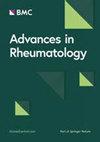阿巴他赛与 TNF 抑制剂对 ACPA 和共享表位阳性类风湿性关节炎患者的疗效比较
IF 2
4区 医学
Q3 RHEUMATOLOGY
引用次数: 0
摘要
HLA-DRB1共有表位(SE)是类风湿性关节炎(RA)发病和RA患者产生抗环瓜氨酸蛋白抗体(ACPA)的危险因素。我们的目的是研究阿帕他赛与肿瘤坏死因子抑制剂(TNFi)对SE和抗环瓜氨酸肽抗体(抗CCP3)阳性的RA患者的实际疗效。阿巴他赛普或 TNFi 初始患者在治疗时或治疗前为 SE + 和抗CCP3 +(> 20 U/mL),且初始时 CDAI 评分为中度或高度(> 10)。主要结果是六个月内 CDAI 评分的平均变化。对倾向得分(PS)修剪和匹配的总体人群以及有生物治疗经验的亚组进行了分析。采用了混合效应模型。在经过PS修剪的总体组群(阿帕赛普,n = 170;TNFi,n = 157)和PS匹配组群(阿帕赛普,n = 111;TNFi,n = 111)中,阿帕赛普和TNFi的CDAI平均变化在数值上有较大改善,但无统计学意义。有生物治疗经验的患者也出现了类似的趋势,但PS修饰队列中CDAI的平均变化达到了统计学意义(阿帕赛普,12.22[95%置信区间(95%CI)10.13至14.31];TNFi,9.28[95%CI 7.08至11.48];P = 0.045)。在这个真实世界的队列中,阿巴他赛普对SE+和ACPA+的RA患者的疗效结果比TNFi有数字上的改善,这与临床试验人群的结果相似。本文章由计算机程序翻译,如有差异,请以英文原文为准。
Comparative effectiveness of abatacept versus TNF inhibitors in rheumatoid arthritis patients who are ACPA and shared epitope positive
The HLA-DRB1 shared epitope (SE) is a risk factor for the development of rheumatoid arthritis (RA) and the production of anti-citrullinated protein antibodies (ACPAs) in RA patients. Our objective was to examine the real-world effectiveness of abatacept versus tumor necrosis factor inhibitors (TNFi) in patients with RA who were SE and anti-cyclic citrullinated peptide antibody (anti-CCP3) positive. Abatacept or TNFi initiators who were SE + and anti-CCP3+ (> 20 U/mL) at or prior to treatment and had moderate or high CDAI score (> 10) at initiation were identified. The primary outcome was mean change in CDAI score over six months. Analyses were conducted in propensity score (PS)-trimmed and -matched populations overall and a biologic-experienced subgroup. Mixed-effects models were used. In the overall PS-trimmed (abatacept, n = 170; TNFi, n = 157) and PS-matched cohorts (abatacept, n = 111; TNFi, n = 111), there were numerically greater improvements in mean change in CDAI between abatacept and TNFi but were not statistically significant. Similar trends were seen for biologic-experienced patients, except that statistical significance was reached for mean change in CDAI in the PS-trimmed cohort (abatacept, 12.22 [95% confidence interval (95%CI) 10.13 to 14.31]; TNFi, 9.28 [95%CI 7.08 to 11.48]; p = 0.045). In this real world cohort, there were numerical improvements in efficacy outcomes with abatacept over TNFi in patients with RA who were SE + and ACPA+, similar to results from a clinical trial population The only statistically significant finding after adjusting for covariates was greater improvement in CDAI with abatacept versus TNFi in the bio-experienced PS-trimmed cohort..
求助全文
通过发布文献求助,成功后即可免费获取论文全文。
去求助
来源期刊

Advances in Rheumatology
Medicine-Rheumatology
CiteScore
4.00
自引率
4.30%
发文量
41
审稿时长
53 weeks
期刊介绍:
Formerly named Revista Brasileira de Reumatologia, the journal is celebrating its 60th year of publication.
Advances in Rheumatology is an international, open access journal publishing pre-clinical, translational and clinical studies on all aspects of paediatric and adult rheumatic diseases, including degenerative, inflammatory and autoimmune conditions. The journal is the official publication of the Brazilian Society of Rheumatology and welcomes original research (including systematic reviews and meta-analyses), literature reviews, guidelines and letters arising from published material.
 求助内容:
求助内容: 应助结果提醒方式:
应助结果提醒方式:


